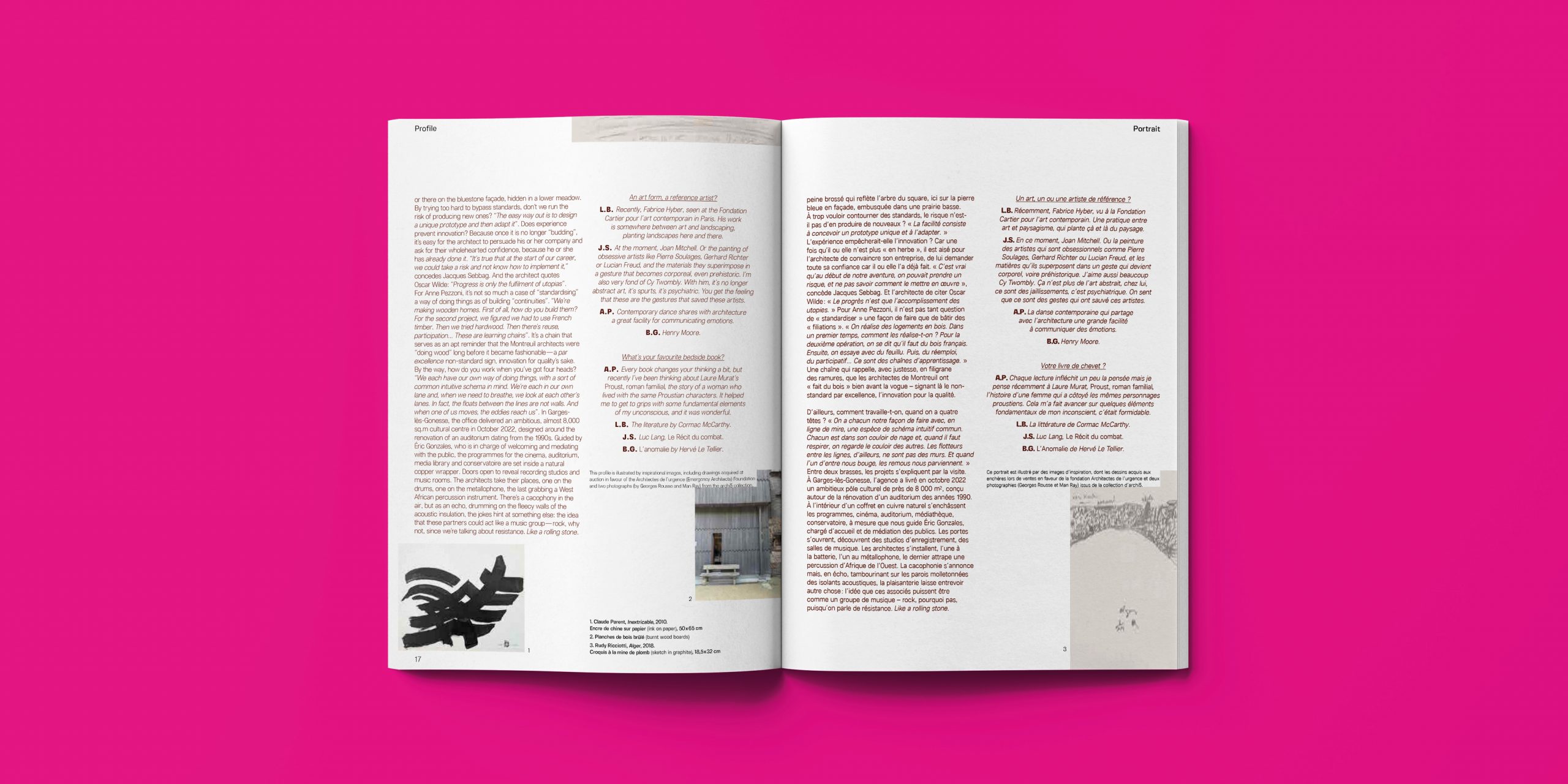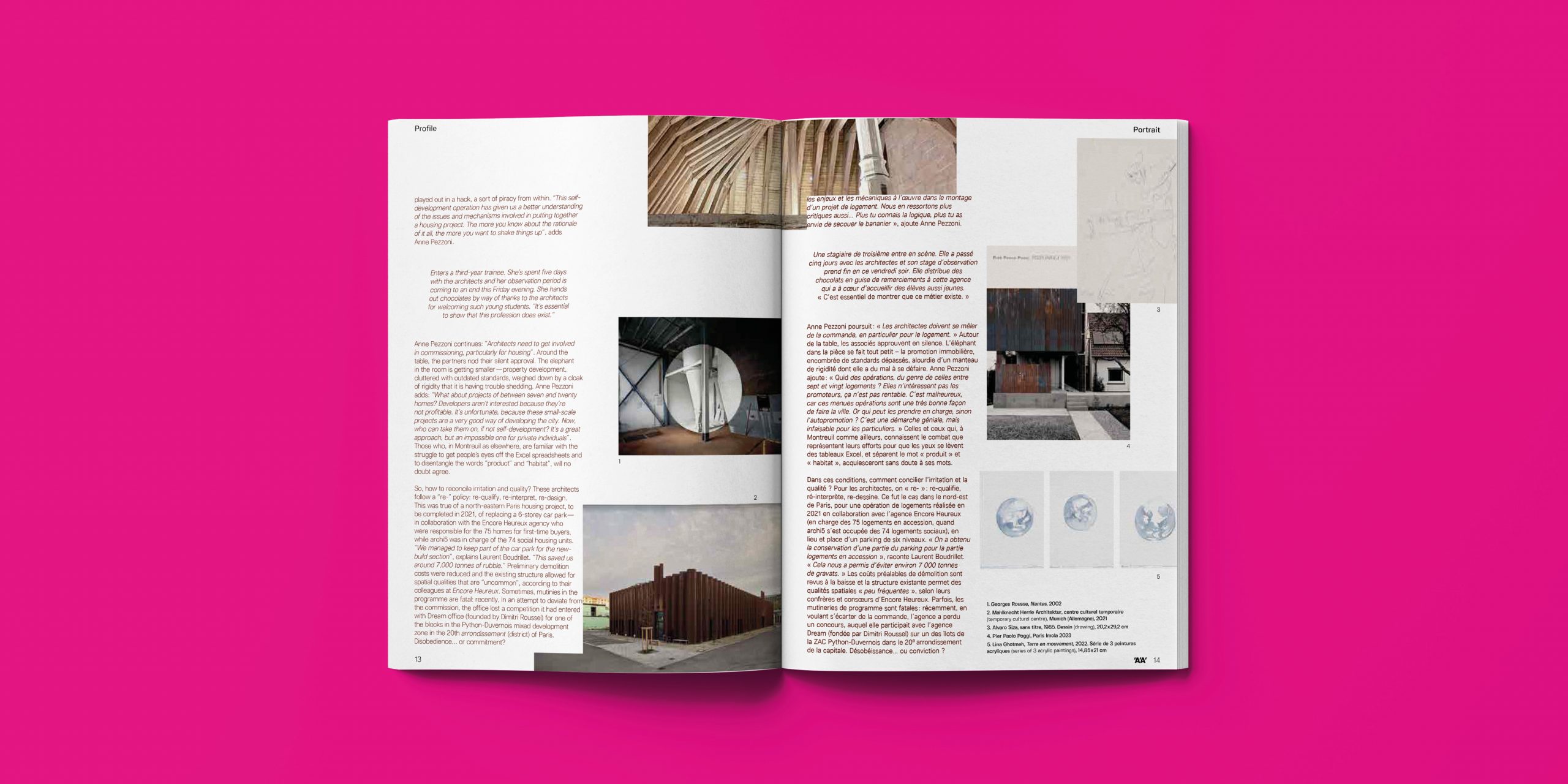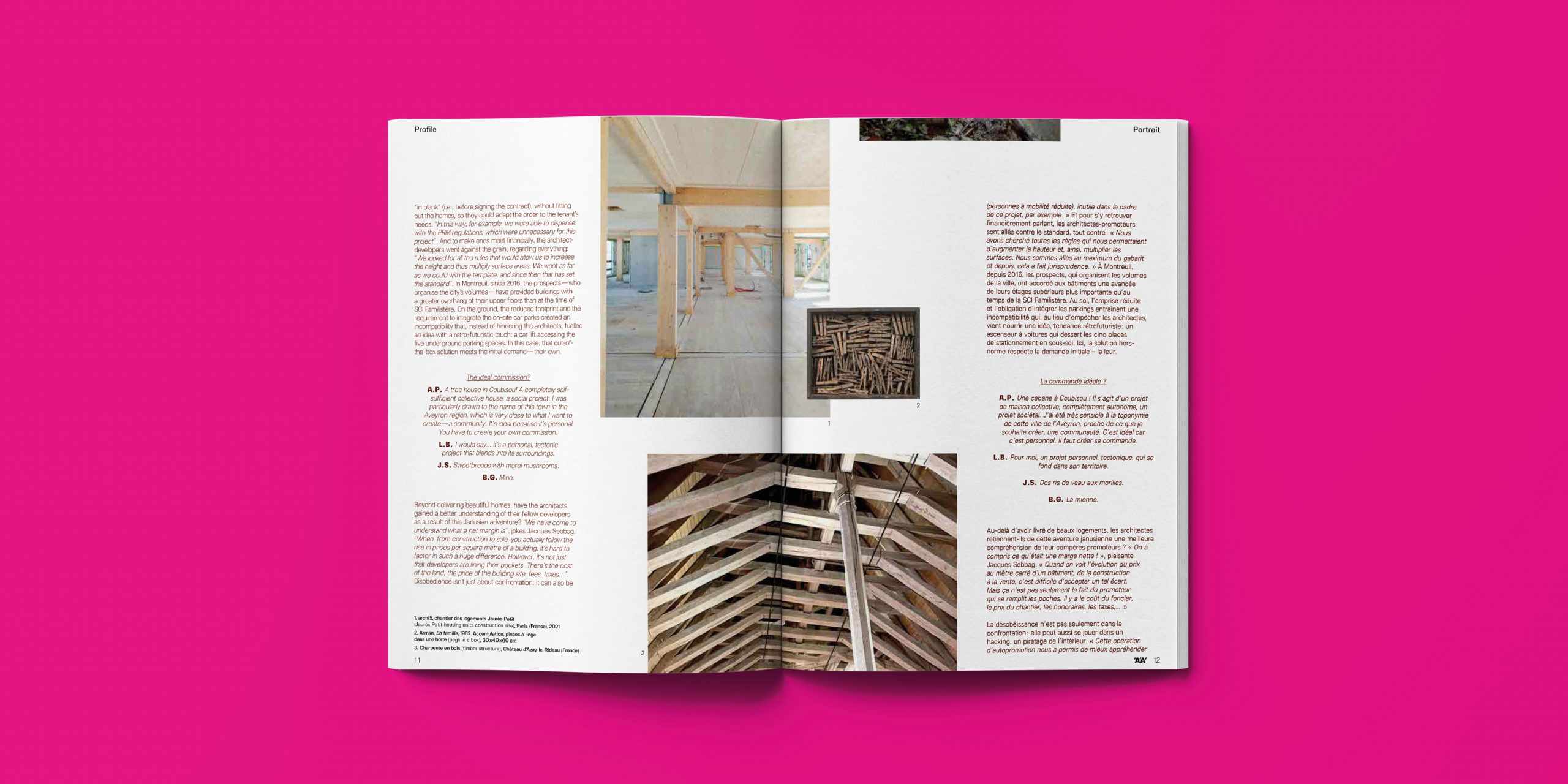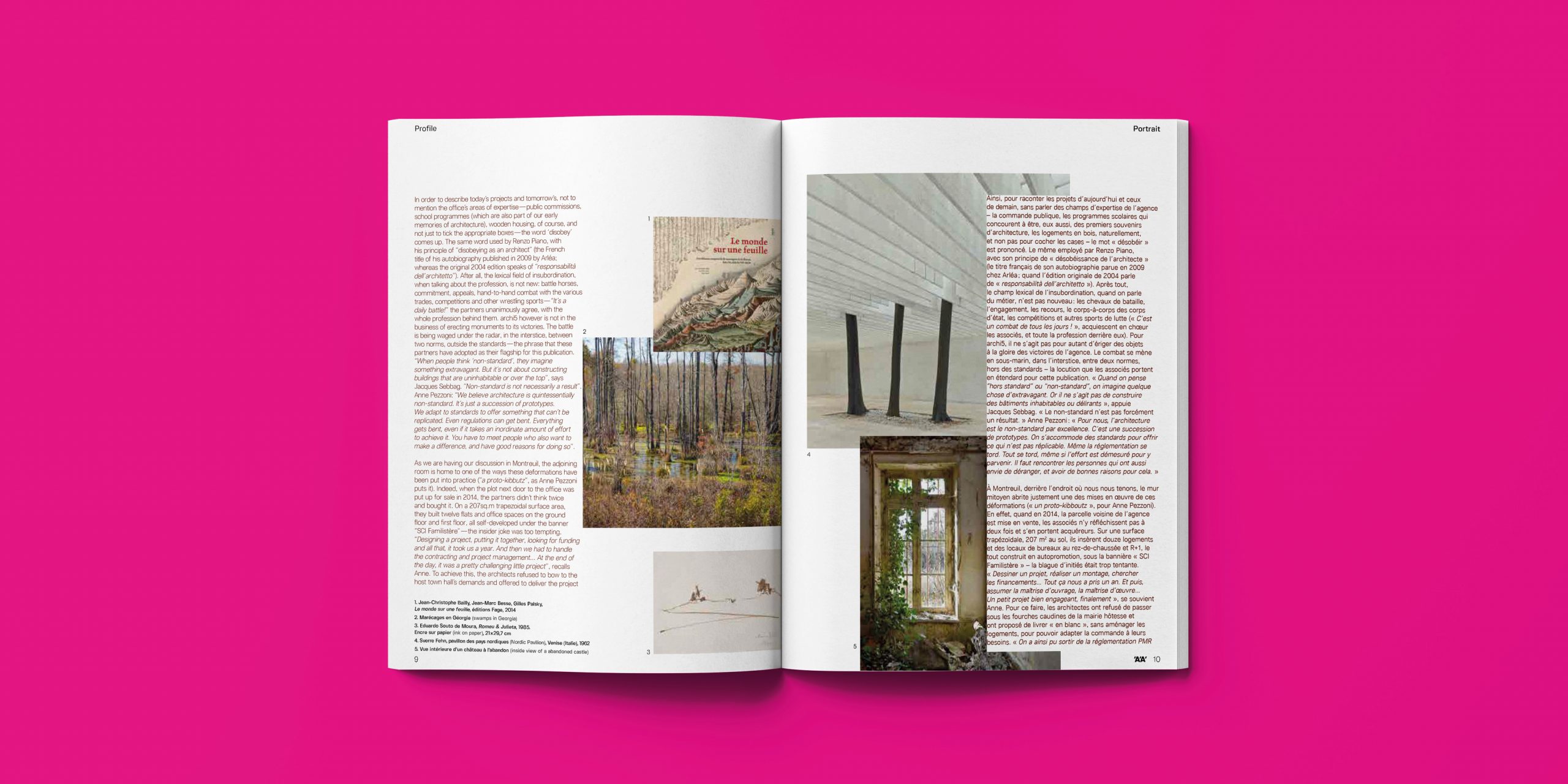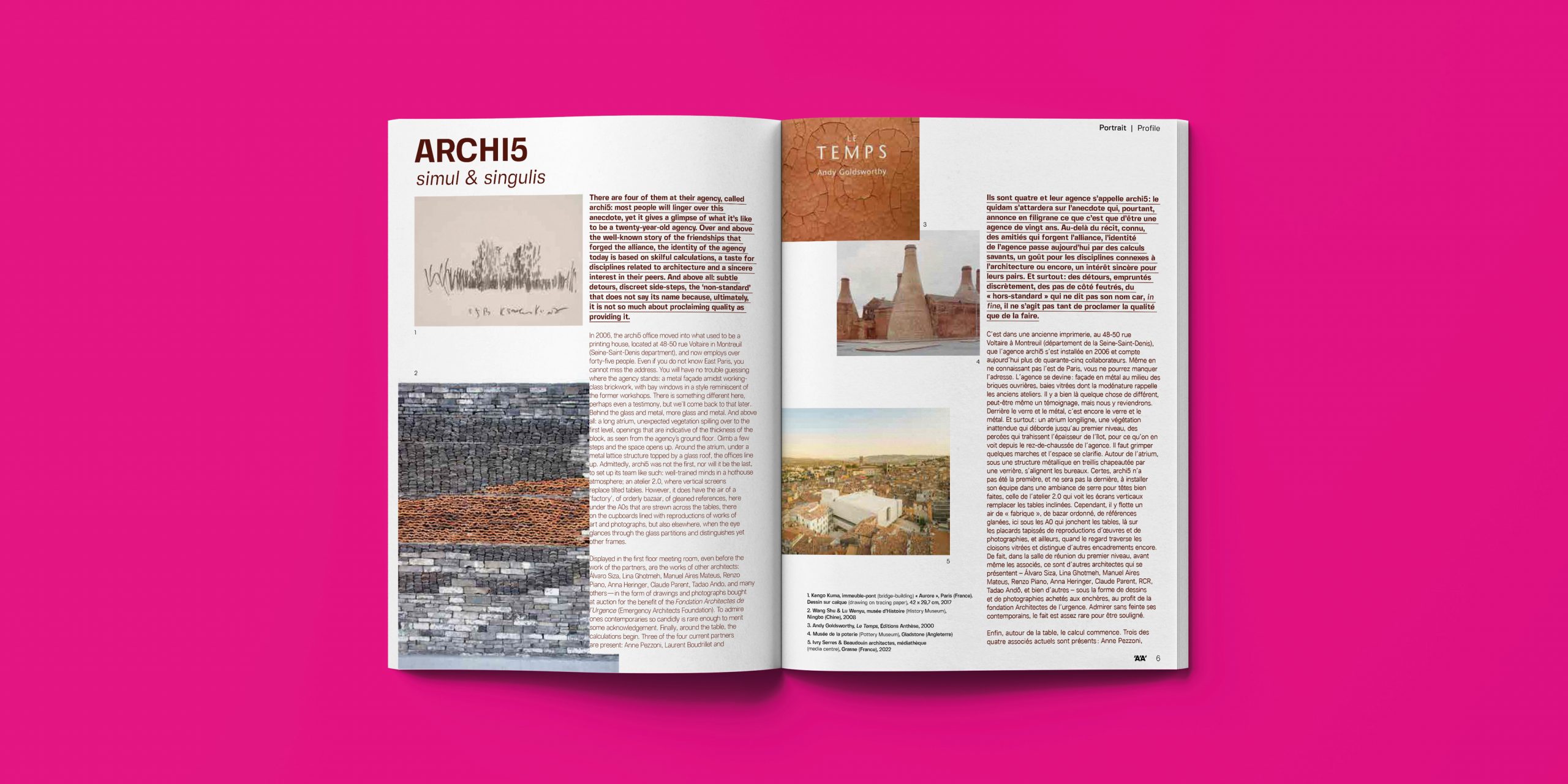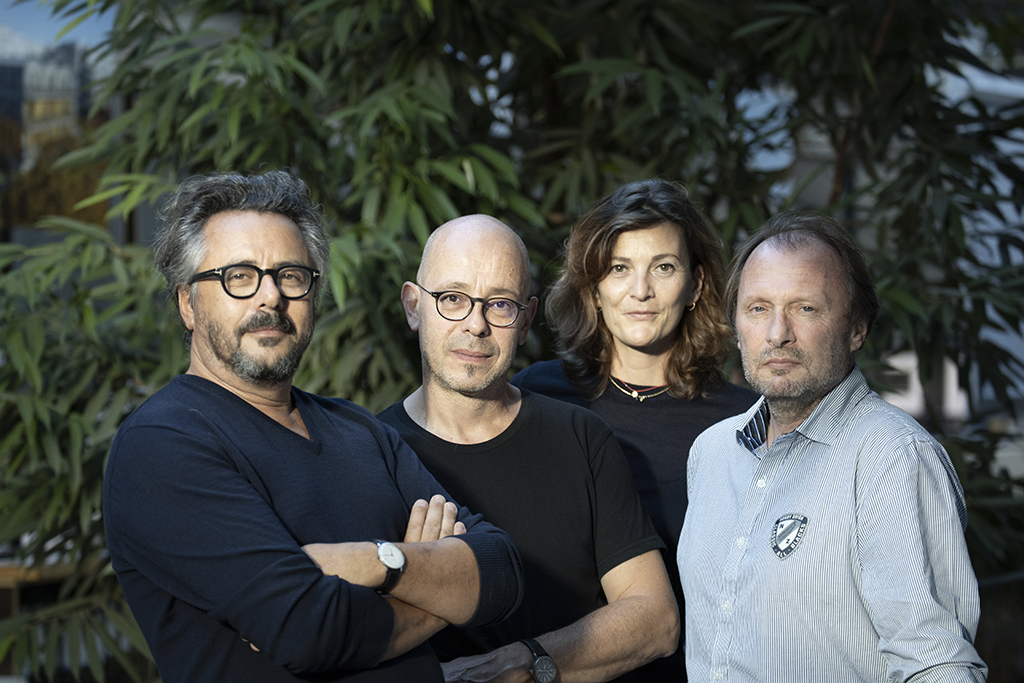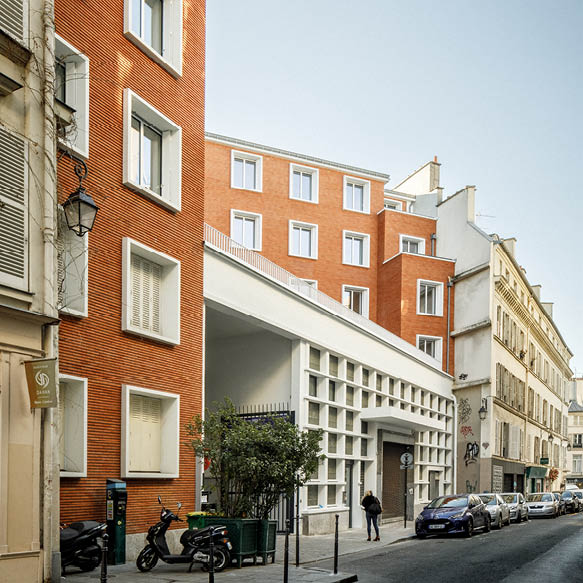archi5, simul & singulis
There are four of them at their agency, called archi5: most people will linger over this anecdote, yet it gives a glimpse of what it’s like to be a twenty-year-old agency. Over and above the well-known story of the friendships that forged the alliance, the identity of the agency today is based on skilful calculations, a taste for disciplines related to architecture and a sincere interest in their peers. And above all: subtle detours, discreet side-steps, the ‘non-standard’ that does not say its name because, ultimately, it is not so much about proclaiming quality as providing it.
By Anastasia de Villepin.
Profile published in the AA special issue No. 49: ‘archi5, offbeat’, available on our eshop.
In 2006, the archi5 office moved into what used to be a printing house, located at 48-50 rue Voltaire in Montreuil (Seine-Saint-Denis department), and now employs over forty-five people. Even if you do not know East Paris, you cannot miss the address. You will have no trouble guessing where the agency stands: a metal façade amidst working-class brickwork, with bay windows in a style reminiscent of the former workshops. There is something different here, perhaps even a testimony, but we’ll come back to that later. Behind the glass and metal, more glass and metal. And above all: a long atrium, unexpected vegetation spilling over to the first level, openings that are indicative of the thickness of the block, as seen from the agency’s ground floor.
Climb a few steps and the space opens up. Around the atrium, under a metal lattice structure topped by a glass roof, the offices line up. Admittedly, archi5 was not the first, nor will it be the last, to set up its team like such: well-trained minds in a hothouse atmosphere; an atelier 2.0, where vertical screens replace tilted tables. However, it does have the air of a ‘factory’, of orderly bazaar, of gleaned references, here under the A0s that are strewn across the tables, there on the cupboards lined with reproductions of works of art and photographs, but also elsewhere, when the eye glances through the glass partitions and distinguishes yet other frames.
Displayed in the first floor meeting room, even before the work of the partners, are the works of other architects: Álvaro Siza, Lina Ghotmeh, Manuel Aires Mateus, Renzo Piano, Anna Heringer, Claude Parent, Tadao Ando, and many others—in the form of drawings and photographs bought at auction for the benefit of the Fondation Architectes de l’Urgence (Emergency Architects Foundation). To admire ones contemporaries so candidly is rare enough to merit some acknowledgement. Finally, around the table, the calculations begin. Three of the four current partners are present: Anne Pezzoni, Laurent Boudrillet and Jacques Sebbag—Bernard Guillien, who was away at the time of our meeting. Along with Laurent and Jacques, Bernard Guillien was one of the agency’s five founders in 2003, which also included Erik Giudice—who left to set up his own agency, EGA, in 2010)—and Thomas Dryjski— who joined Paris-based agency DVVD in 2015.
Since then, water has flowed under this bridge, taking with it a little of the camaraderie forged at C+H+, Paul Chemetov and Borja Huidobro’s architectural practice—which was the five partners’ last place of employment after their studies at the Belleville École nationale supérieure d’architecture. You’ve heard the history, now “we’re here to talk about today, and tomorrow”, asserts Jacques Sebbag. No need to review the 70 or so projects delivered since 2003 to portray this twenty-year-old agency. The catalogue is noble, but the personalities around the table have something else to say.
In 2018, the office took part in an exercise—suggested by L’Architecture d’Aujourd‘hui—of answering questions about their vision of the profession, their inspirations and their credo, in the style of a ‘Proust questionnaire’. Six years later, the three partners present are back in the saddle (and Bernard Guillien will also answer later on). With one voice? “No, there’s no point in being an association if you’re going to speak for everyone. On the contrary, you need to be able to develop your own unique style”, says Anne Pezzoni. Jacques Sebbag likes refering to the theatre: “I think of the Comédie-Française’s motto, simul et singulis; being together and being yourself”.
What is your first memory of architecture?
Anne Pezzoni : My first memory of architecture is of my school. But I didn’t know it was architecture. It was a school built in the 1970s, with lots of windows and an open outlook on the landscape. It was an unconscious spatial experience. I discovered the discipline later.
Laurent Boudrillet : I came to architecture somewhat by chance, actually. My parents lived in the countryside in Haute-Saône. The only well-known building in Haute-Saône is the Notre-Dame du Haut chapel in Ronchamp.
Jacques Sebbag : A love of drawing, models and anatomy. I remember my science notebooks where I would draw the structures of the body. I looked at what profession corresponded to my
interests, and I came across architecture.
Bernard Guillien : The Villa Suissa in Casablanca.
In order to describe today’s projects and tomorrow’s, not to mention the office’s areas of expertise—public commissions, school programmes (which are also part of our early memories of architecture), wooden housing, of course, and not just to tick the appropriate boxes—the word ‘disobey’ comes up. The same word used by Renzo Piano, with his principle of “disobeying as an architect” (the French title of his autobiography published in 2009 by Arléa;whereas the original 2004 edition speaks of “responsabilità dell’architetto”). After all, the lexical field of insubordination, when talking about the profession, is not new: battle horses, commitment, appeals, hand-to-hand combat with the various trades, competitions and other wrestling sports—“It’s a daily battle!” the partners unanimously agree, with the whole profession behind them.
archi5 however is not in the business of erecting monuments to its victories. The battle is being waged under the radar, in the interstice, between two norms, outside the standards—the phrase that these partners have adopted as their flagship for this publication. “When people think ‘non-standard’, they imagine something extravagant. But it’s not about constructing buildings that are uninhabitable or over the top”, says Jacques Sebbag. “Non-standard is not necessarily a result”. Anne Pezzoni: “We believe architecture is quintessentially non-standard. It’s just a succession of prototypes. We adapt to standards to offer something that can’t be replicated. Even regulations can get bent. Everything gets bent, even if it takes an inordinate amount of effort to achieve it. You have to meet people who also want to make a difference, and have good reasons for doing so”.
As we are having our discussion in Montreuil, the adjoining room is home to one of the ways these deformations have been put into practice (“a proto-kibbutz”, as Anne Pezzoni puts it). Indeed, when the plot next door to the office was put up for sale in 2014, the partners didn’t think twice and bought it. On a 207sq.m trapezoidal surface area, they built twelve flats and office spaces on the ground floor and first floor, all self-developed under the banner “SCI Familistère”—the insider joke was too tempting. “Designing a project, putting it together, looking for funding and all that, it took us a year. And then we had to handle the contracting and project management… At the end of the day, it was a pretty challenging little project”, recalls Anne. To achieve this, the architects refused to bow to the host town hall’s demands and offered to deliver the project “in blank” (i.e., before signing the contract), without fitting out the homes, so they could adapt the order to the tenant’s needs.
“In this way, for example, we were able to dispense with the PRM regulations, which were unnecessary for this project”. And to make ends meet financially, the architect-developers went against the grain, regarding everything: “We looked for all the rules that would allow us to increase the height and thus multiply surface areas. We went as far as we could with the template, and since then that has set the standard”. In Montreuil, since 2016, the prospects—who organise the city’s volumes—have provided buildings with a greater overhang of their upper floors than at the time of SCI Familistère. On the ground, the reduced footprint and the requirement to integrate the on-site car parks created an incompatibility that, instead of hindering the architects, fuelled an idea with a retro-futuristic touch: a car lift accessing the five underground parking spaces. In this case, that out-of-the-box solution meets the initial demand—their own.
The ideal commission?
A.P. : A tree house in Coubisou! A completely self-sufficient collective house, a social project. I was particularly drawn to the name of this town in the Aveyron region, which is very close to what I want to create—a community. It’s ideal because it’s personal. You have to create your own commission.
L.B. : I would say… it’s a personal, tectonic project that blends into its surroundings.
J.S. : Sweetbreads with morel mushrooms.
B.G. : Mine.
Beyond delivering beautiful homes, have the architects gained a better understanding of their fellow developers as a result of this Janusian adventure? “We have come to understand what a net margin is”, jokes Jacques Sebbag. “When, from construction to sale, you actually follow the rise in prices per square metre of a building, it’s hard to
factor in such a huge difference. However, it’s not just that developers are lining their pockets. There’s the cost of the land, the price of the building site, fees, taxes…”.
Disobedience isn’t just about confrontation: it can also be played out in a hack, a sort of piracy from within. “This self-development operation has given us a better understanding of the issues and mechanisms involved in putting together a housing project. The more you know about the rationale of it all, the more you want to shake things up”, adds Anne Pezzoni.
Enters a third-year trainee. She’s spent five days with the architects and her observation period is coming to an end this Friday evening. She hands out chocolates by way of thanks to the architects for welcoming such young students. “It’s essential to show that this profession does exist.“
Anne Pezzoni continues: “Architects need to get involvedin commissioning, particularly for housing”. Around the table, the partners nod their silent approval. The elephant in the room is getting smaller—property development, cluttered with outdated standards, weighed down by a cloak of rigidity that it is having trouble shedding. Anne Pezzoni adds: “What about projects of between seven and twenty homes? Developers aren’t interested because they’re not profitable. It’s unfortunate, because these small-scale projects are a very good way of developing the city. Now, who can take them on, if not self-development? It’s a great approach, but an impossible one for private individuals”. Those who, in Montreuil as elsewhere, are familiar with the struggle to get people’s eyes off the Excel spreadsheets and to disentangle the words “product” and “habitat”, will no doubt agree.
So, how to reconcile irritation and quality? These architects follow a “re-” policy: re-qualify, re-interpret, re-design. This was true of a north-eastern Paris housing project, to be completed in 2021, of replacing a 6-storey car park—in collaboration with the Encore Heureux agency who were responsible for the 75 homes for first-time buyers, while archi5 was in charge of the 74 social housing units. “We managed to keep part of the car park for the new-build section”, explains Laurent Boudrillet. “This saved us around 7,000 tonnes of rubble.” Preliminary demolition costs were reduced and the existing structure allowed for spatial qualities that are “uncommon”, according to their colleagues at Encore Heureux. Sometimes, mutinies in the programme are fatal: recently, in an attempt to deviate from the commission, the office lost a competition it had entered with Dream office (founded by Dimitri Roussel) for one of the blocks in the Python-Duvernois mixed development zone in the 20th arrondissement (district) of Paris. Disobedience… or commitment?
To build the Lycée Marcel Sembat, completed in 2011 in Sotteville-lès-Rouen, the architects demolished a 1960s building, though it was forbidden, and combined urban planning, architecture and landscape, with broad wings stretching across the Normandy countryside. “Recently, one of the competitors reminded us of this episode: ‘You won all right, but you tore down this building that you weren’t allowed to demolish!’. That was back in 2005, and it obviously left a lasting impression on him”, the architects recall with a laugh. Fortunately, the tabula wasn’t rasa just for the sake of enjoying a clean slate. The possibility of demolition unblocked an intuition, a premonitory drawing: a carpet of vegetation under which to tuck away the workshops—often under-valued—of the lycée’s technical courses.
Being an architect means…
L.B. : Creating places to live and socialise that interact with the urban context, like a piece of land art.
J.S. : Forgetting to be an architect; working with the seriousness of a child having fun, to paraphrase Adolf Loos.
A.P. : Believing that place can influence life. What interests me in architecture is what it produces, the projection of life that takes place there, rather than the actual creation.
B.G. : To live your passion.
An enthusiastic supporter of public contracts, archi5 knows that it is working for the common good. Anne Pezzoni adds: “Going beyond is the essence of our profession. When we talk to clients, they often say, ‘Oh, I hadn’t thought of that’. It’s a bit like when an astrophysicist popularises something”. Jacques Sebbag refers to this “conversion of text into building”, which needs to be systematically explained. The example of the Lycée Marcel Sembat is a case in point. Once the uproar has been forgiven, at archi5 we quickly move on to the form, the landscape, the efforts to avoid jaggedness and choose the right stitching thread. “As an architect, I feel responsible for the liability of producing ugliness that is linked to stylistic gimmicks… Architects love to crow about the ‘poetry’ of urban ugliness. I don’t agree with that”, adds Anne Pezzoni. “The real issue is also: how do we break away from the desire to ‘mark our time’, to create an object that is frozen in a stylistic stereotype?”
For architects, “nestling” the object in its environment is one of the solutions they like best. Laurent Boudrillet has mentioned land art on several occasions, and the more the word comes up in conversation—conversations about the the moor, about art—the more this subtle common strand emerges. As can be found here in the reflection of a
barely brushed metal alloy, reflecting the tree in the square, or there on the bluestone façade, hidden in a lower meadow.
An art form, a reference artist?
L.B. : Recently, Fabrice Hyber, seen at the Fondation Cartier pour l’art contemporain in Paris. His work is somewhere between art and landscaping, planting landscapes here and there.
J.S. : At the moment, Joan Mitchell. Or the painting of obsessive artists like Pierre Soulages, Gerhard Richter or Lucian Freud, and the materials they superimpose in a gesture that becomes corporeal, even prehistoric. I’m also very fond of Cy Twombly. With him, it’s no longer abstract art, it’s spurts, it’s psychiatric. You get the feeling that these are the gestures that saved these artists.
A.P. : Contemporary dance shares with architecture a great facility for communicating emotions.
B.G. : Henry Moore.
By trying too hard to bypass standards, don’t we run the risk of producing new ones? “The easy way out is to design a unique prototype and then adapt it”. Does experience prevent innovation? Because once it is no longer “budding”, it’s easy for the architect to persuade his or her company and ask for their wholehearted confidence, because he or she has already done it. “It’s true that at the start of our career, we could take a risk and not know how to implement it,” concedes Jacques Sebbag. And the architect quotes Oscar Wilde: “Progress is only the fulfilment of utopias”.
For Anne Pezzoni, it’s not so much a case of “standardising” a way of doing things as of building “continuities”. “We’re making wooden homes. First of all, how do you build them? For the second project, we figured we had to use French timber. Then we tried hardwood. Then there’s reuse, participation… These are learning chains”. It’s a chain that serves as an apt reminder that the Montreuil architects were “doing wood” long before it became fashionable—a par excellence non-standard sign, innovation for quality’s sake. By the way, how do you work when you’ve got four heads? “We each have our own way of doing things, with a sort of common intuitive schema in mind. We’re each in our own lane and, when we need to breathe, we look at each other’s lanes. In fact, the floats between the lines are not walls. And when one of us moves, the eddies reach us”.
In Garges-lès-Gonesse, the office delivered an ambitious, almost 8,000 sq.m cultural centre in October 2022, designed around the renovation of an auditorium dating from the 1990s. Guided by Éric Gonzales, who is in charge of welcoming and mediating with the public, the programmes for the cinema, auditorium, media library and conservatoire are set inside a natural copper wrapper. Doors open to reveal recording studios and music rooms. The architects take their places, one on the drums, one on the metallophone, the last grabbing a West African percussion instrument. There’s a cacophony in the air, but as an echo, drumming on the fleecy walls of the acoustic insulation, the jokes hint at something else: the idea that these partners could act like a music group—rock, why not, since we’re talking about resistance. Like a rolling stone.
What’s your favourite bedside book?
A.P. : Every book changes your thinking a bit, but recently I’ve been thinking about Laure Murat’s Proust, roman familial, the story of a woman who lived with the same Proustian characters. It helped me to get to grips with some fundamental elements of my unconscious, and it was wonderful.
L.B. : The literature by Cormac McCarthy.
J.S. : Luc Lang, Le Récit du combat.
B.G. : L’anomalie by Hervé Le Tellier.
Read the AA special issue No. 49: ‘archi5, offbeat’, available on our eshop.


